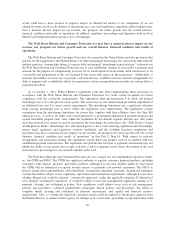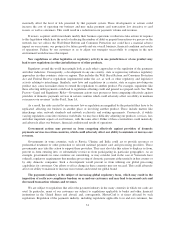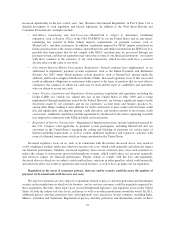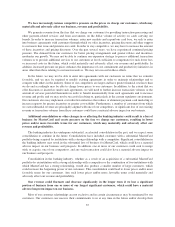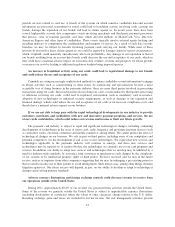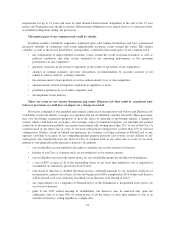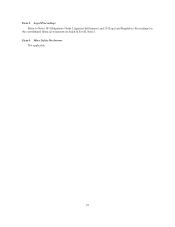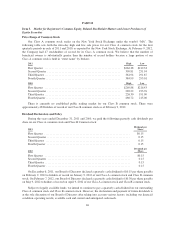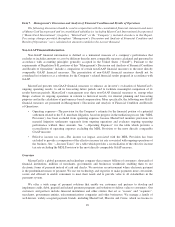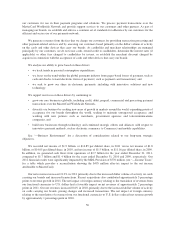MasterCard 2011 Annual Report Download - page 44
Download and view the complete annual report
Please find page 44 of the 2011 MasterCard annual report below. You can navigate through the pages in the report by either clicking on the pages listed below, or by using the keyword search tool below to find specific information within the annual report.incurred during these ordinary course activities of MasterCard. While we believe that we have sufficient liquidity
to cover a settlement failure by our largest customer on its peak day, the term and amount of our guarantee of
obligations to principal customers is unlimited. As a result, concurrent settlement failures of more than one of our
larger customers or of several of our smaller customers either on a given day or over a condensed period of time
may exceed our available resources and could materially and adversely affect our business and financial
condition. In addition, even if we have sufficient liquidity to cover a settlement failure, we may not be able to
recover the cost of such a payment and may therefore be exposed to significant losses, which could materially
and adversely affect our results of operations, cash flow and financial condition. Moreover, during 2011, many of
our financial institution customers continued to be directly and adversely impacted by the unprecedented events
in the financial markets which began during 2008 and the economic turmoil that has ensued. The European
financial crisis remains a heightened concern. Our aggregate gross settlement exposures to Italy, Spain, Greece
and Portugal, four of the countries most significantly impacted by the eurozone crisis, are less than 5% of our
total gross settlement exposure and are being managed through various planning and mitigation practices.
Nonetheless, these conditions present increased risk that we may have to perform under our settlement
guarantees.
Separately, MasterCard also provides guarantees to customers and certain other companies indemnifying
them from losses stemming from failures of third parties to perform. For more information on our settlement
exposure and risk assessment and mitigation practices as of December 31, 2011, see Note 21 (Settlement and
Other Risk Management) to the consolidated financial statements included in Part II, Item 8 of this Report.
If our transaction processing systems and other services are disrupted or we are unable to process
transactions or service our customers efficiently or at all, our revenue or profitability would be materially
reduced.
Our transaction processing systems and other services may experience service interruptions as a result of
process or other technology malfunction, fire, natural or man-made disasters, power loss, disruptions in long
distance or local telecommunications access, fraud, terrorism, accident or other catastrophic events. A disaster or
other problem at our primary and/or back-up facilities or our other owned or leased facilities could interrupt our
services. Our visibility in the global payments industry may also attract terrorists, activists or hackers to attack
our facilities or systems. We routinely receive cyber-threats of varying levels. Any actual attacks could lead to
service interruptions, increased costs or data security compromises. If such attacks are not detected immediately,
their effect could be compounded. We maintain an information security program, a business continuity program
and insurance coverage, and our processing systems incorporate multiple levels of protection, in order to address
or otherwise mitigate these risks. Despite these mitigation efforts, however, we cannot ensure that the security
infrastructure of our processing systems would be immune to these risks.
Additionally, we rely on third-party service providers for the timely transmission of information across our
global data transportation network. Inadequate infrastructure in lesser developed markets could also result in
service disruptions, which could impact our ability to do business in those markets. If one of our service
providers fails to provide the communications capacity or services we require, as a result of natural disaster,
operational disruptions, terrorism, hacking or other cybersecurity incidents or any other reason, the failure could
interrupt our services. Because of the intrinsic importance of our processing systems to our business, any
interruption or degradation could adversely affect the perception of our brands’ reliability and materially reduce
our revenue or profitability.
Account data breaches involving card data stored, processed or transmitted by us or third parties
could adversely affect our reputation and revenue.
We, our customers, merchants, and other third parties process, transmit or store cardholder account and
other information in connection with payment cards. In addition, our customers may sponsor third-party
processors to process transactions generated by cards carrying our brands and merchants may use third parties to
40


